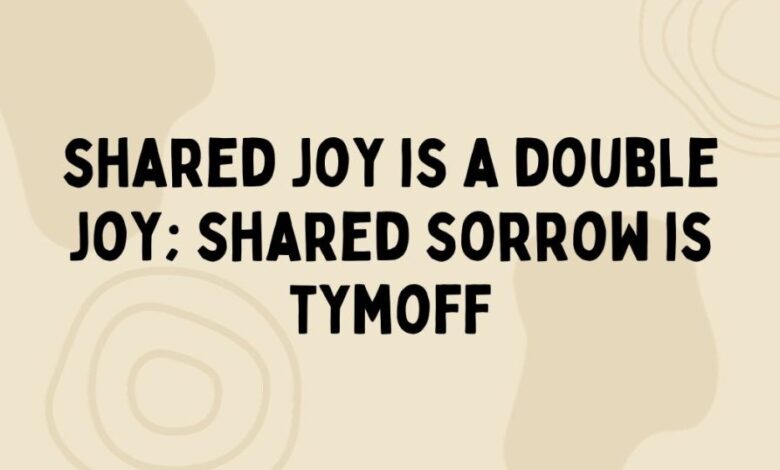shared joy is a double joy; shared sorrow is tymoff

Shared experiences form the cornerstone of human connection shaping our emotional landscapes and social interactions. In both moments of joy and sorrow, the act of sharing intensifies the emotional impact underscoring the proverbial adage “Shared joy is a double joy; shared sorrow is tymoff.” This article delves into the profound implications of shared emotions, exploring their significance, dynamics, and societal relevance.
The Concept of Shared Joy
Joy in its essence is magnified when shared with others. Whether it’s celebrating personal achievements, milestones, or simply reveling in life’s simple pleasures, the act of sharing joy fosters camaraderie and strengthens bonds. From jubilant communal gatherings to heartfelt expressions of happiness among loved ones, shared joy enhances the overall experience, creating lasting memories and deepening connections.
Understanding Shared Sorrow
Conversely, sorrow becomes more bearable when shared with empathetic companions. The burden of grief, loss, or hardship is lightened through collective empathy and support. Shared sorrow acknowledges the universality of human suffering and offers solace in shared experiences of pain and adversity. Through communal mourning rituals or heartfelt expressions of sympathy, individuals find comfort in each other’s presence, reaffirming the resilience of the human spirit.
Contrast between Shared Joy and Shared Sorrow
While both shared joy and shared sorrow entail emotional communion, they differ in their underlying dynamics and societal implications. Shared joy often evokes feelings of unity, celebration, and mutual upliftment, whereas shared sorrow elicits empathy, compassion, and solidarity in times of distress. The contrast between these emotions underscores the complexity of human relationships and the diverse range of experiences that shape our collective consciousness.
The Essence of Shared Experience
At its core shared experience transcends individual narratives fostering a sense of belonging and mutual understanding. Whether through cultural traditions communal celebrations, or collective mourning, shared experiences enrich our lives and deepen our connections with others. By embracing the joys and sorrows of life together, we cultivate empathy, resilience, and a shared sense of humanity.
Cultural and Historical Perspectives
Throughout history communities have relied on shared rituals and traditions to commemorate joyous occasions and navigate periods of sorrow. From cultural festivals and religious ceremonies to communal grieving practices, the collective experience plays a pivotal role in shaping cultural identity and fostering social cohesion. These shared traditions serve as a testament to the enduring power of human connection in times of both celebration and adversity.
Psychological and Sociological Insights
From a psychological standpoint sharing emotions promotes emotional well-being and strengthens interpersonal relationships. Research suggests that individuals who openly express their feelings and receive support from others experience greater psychological resilience and overall life satisfaction. Sociological studies highlight the role of shared experiences in building social capital and fostering community cohesion thereby enhancing the fabric of society.
Benefits of Sharing Joy and Sorrow
The act of sharing joy and sorrow offers numerous benefits including emotional support, strengthened relationships, and a heightened sense of belonging. By acknowledging and validating each other emotions individuals cultivate deeper connections and forge bonds built on empathy and understanding. Shared experiences foster resilience and fortify communities, enabling individuals to navigate life’s ups and downs with greater courage and resilience.
Challenges in Sharing Emotions
Despite the inherent benefits of sharing emotions individuals may encounter obstacles such as fear of vulnerability or cultural stigma. The reluctance to express genuine feelings or seek support from others can hinder emotional connection and perpetuate feelings of isolation. Overcoming these barriers requires a concerted effort to create safe spaces for open dialogue and foster a culture of empathy and acceptance.
Strategies for Effective Sharing
To facilitate meaningful emotional exchange, it’s essential to cultivate active listening skills and create environments where individuals feel comfortable expressing their feelings without judgment. Encouraging open dialogue and practicing empathy can foster deeper connections and strengthen interpersonal relationships. Leveraging technology to build virtual support networks and online communities can provide avenues for individuals to share their joys and sorrows with a broader audience.
The Role of Technology
In an increasingly digital world technology plays a pivotal role in facilitating emotional connection and shared experiences. Virtual platforms and social media networks offer opportunities for individuals to connect, share stories, and find support from like-minded peers. Whether through online support groups, virtual events, or social media campaigns, technology serves as a catalyst for fostering empathy and solidarity across diverse communities.
Impact on Personal Growth
Embracing shared experiences of joy and sorrow not only enhances social connection but also promotes personal growth and development. By navigating life’s challenges together, individuals cultivate resilience, empathy, and emotional intelligence. These experiences contribute to the cultivation of a more compassionate and interconnected society where individuals support each other through both triumphs and tribulations.
Case Studies
Numerous real-life examples illustrate the profound impact of shared joy and shared sorrow on individuals and communities alike. From grassroots movements that harness the power of collective action to personal anecdotes of resilience and solidarity these case studies highlight the transformative potential of shared experiences in shaping human behavior and societal norms.
Practical Applications
Implementing practices that encourage the sharing of emotions and experiences can have far-reaching effects on individual well-being and community cohesion. By fostering open dialogue creating supportive environments and leveraging technology to facilitate connections organizations and communities can promote emotional resilience and strengthen social bonds.
Conclusion
Shared joy and shared sorrow serve as poignant reminders of our shared humanity fostering empathy resilience and community cohesion. By embracing these emotions and actively engaging in meaningful emotional exchange individuals can cultivate deeper connections strengthen relationships, and navigate life’s ups and downs with courage and compassion.



